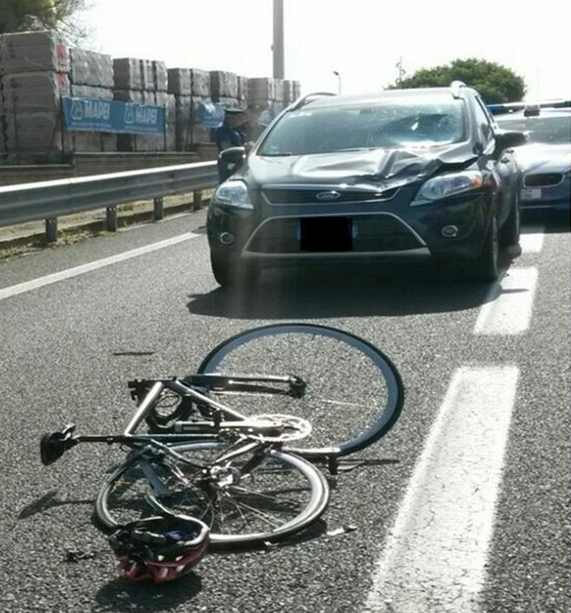- Livio De Angelis
- Original Article
The First Aid on the Scene of the Crime: the possible coexistence of clinical and investigative necessity
- 1/2017-Febbraio
- ISSN 2532-1285
De Angelis Livio(1), Dell’Aquila Lucrezia(2), Piccolo Carlo(3), Vanzo Cinzia(4), Arcuri Maurizio(5)

Omicidio stradale (art 589 bis c.p.), via Aurelia, Roma
Abstract
The following document tells about the management of a crime scene with the definition of rules of behavior in order to support the activities of all the actors that interact with the same in line with the views expressed by the European Union and the Council of Europe.
The first operation is the initial link in the chain of successive activities that constitute the survey as a whole and by the quality of each phase it depends the quality of the next. The principle of exchange of Locard states that “every contact leaves a trace.”
Introduction
Discussion
- First of all is surely to use personal protective equipment, in particular latex gloves and covers, boot covers, even better if you use headphones and masks;
The use personal protective equipment must be worn before entering the same scene in order to also preserve the path that may have been used by the attacker (take for example how much information can give a door handle), and only removed after leaving the scene. They must never be abandoned on the scene at the end of operations. These features prevent the pollution of the scene with foreign elements such as fingerprints or shoe tracks, hair and other; - More expedient that the staff 118 should take to move the victim, for example when it is necessary to turn it in the supine position for the clinical evaluation, it is to remember exactly what was the original position of the same one to can report to the investigators;
- The movement of the victim must be carried out only when necessary;
- If you need to find out the victim’s chest to attach electrodes and document asystole, you should avoid cutting the clothing at the entrance holes of bullets or blades, and in correspondence with wounds;
- You have to avoid touching the victim’s hands and would be appropriate, if you have to move the body, protect them by putting them in plastic bags, as on the hands and under fingernails are often detectable traces or fragments of materials (organic material or textile fibers ) important for the investigations; consider, for example in the case of the victim that in an attempt to defend himself had scratched her attacker;
- Do not touch or move furniture, furnishings, or surrounding objects unless absolutely necessary;
- Leave the doors and windows as well as we found them, especially not touch the handles with your bare hands;
- Do not turn on or off lights and lamps but leave them as we found them;
- Never use the bathrooms present at the crime scene, do not flush the toilet, do not open or close the taps even for washing hands, leave everything as we found it;
- Never smoke at the scene of a crime to not add to the scene ashes or cigarette butts;
- Not to leave the scene or on the victim’s body objects or materials used in the rescue operations;
- If the crime scene is a motor vehicle, must not be opened or closed the windows and doors if not necessary to reach the victim, handles and buttons compartment are touched only with gloves.
- If the car is in moving and you must switch off the engine for safety reasons you should turn the key touching with gloves and leaving it inserted in the framework.
- As a last recommendation for the rescue team leader can underline the importance of framing and remember the crime scene even if possible with photographic documentation as it appears on our arrival, the number and the attitudes of people staying there, their faces and write down a rescue tab.
Conclusions
The acquisition and the sharing of specific behaviors allows rescuers to achieve the objectives while also allowing investigators on the crime scene to do their work creating a synergy among various professional roles.
Bibliography
-
TL-Rogers. Crime scene ethics: souvenirs, teaching material, and artifacts.J Forensic Sci 2004 Sea; 307-11. PMID: 15027551 [PubMed indexed for MEDLINE].
-
Cale CM, Earll ME, Latham KE, Bush GL.Could Secondary DNA Transfer Falsely Place Someone at the Scene of a Crime?J Forensic Sci 2016 Sep; 61 (1): 196-203.PMID: 27621071 [PubMed indexed for MEDLINE].
-
V. Liviero. Il sopralluogo medico legale. Scienze forensi. Teoria e prassi dell’ investigazione scientifica, a cura di M. Picozzi, A. Intini. Milan, 2009, 45.
-
A. Giardia. Manuale di Procedura Penale. Ipsoa, Assago, 2016.
-
Fiandaca G., E. Musco. Diritto Penale. Zanichelli, Firenze, 2014.
-
Protocolli Operativi Centrale Operativa Sues Roma Città Metropolitana. ARES 118.

